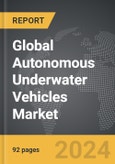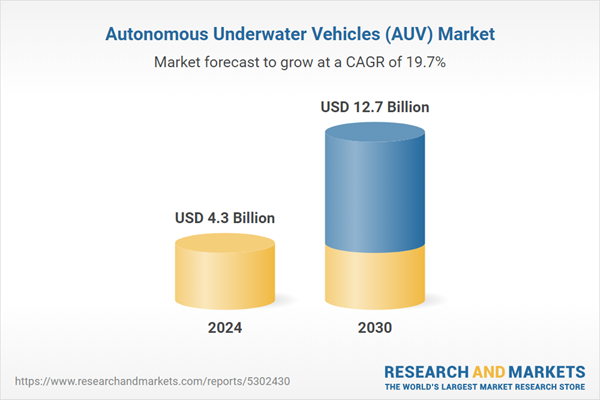Global Autonomous Underwater Vehicles (AUV) Market - Key Trends and Drivers Summarized
What Are Autonomous Underwater Vehicles (AUVs), and How Are They Revolutionizing Ocean Exploration?
Autonomous Underwater Vehicles (AUVs) are sophisticated robotic systems capable of navigating underwater without human control, marking a transformative shift in ocean exploration. Unlike remotely operated vehicles (ROVs), which require a tethered connection to a vessel for operation, AUVs are fully independent, programmed to follow specific missions autonomously using onboard sensors and advanced navigation algorithms. AUVs rely on an array of technologies, including sonar, inertial navigation, and imaging sensors, to map underwater terrain, collect environmental data, and avoid obstacles while executing pre-defined tasks. Their independence enables them to reach depths and regions of the ocean that are challenging or impossible for humans to access, capturing high-resolution data in extreme, high-pressure environments. This ability to operate autonomously, even in remote oceanic regions, has made AUVs essential tools in marine research, environmental monitoring, and underwater resource exploration. As AUV technology continues to develop, these vehicles are becoming indispensable in understanding and conserving the oceans, while also supporting industries seeking sustainable ways to explore and utilize marine resources. From mapping unknown seabeds to tracking ocean currents and collecting samples, AUVs offer new opportunities for scientific discovery and commercial applications in some of the planet's least accessible environments.How Are AUVs Being Applied Across Different Sectors?
Autonomous Underwater Vehicles are versatile systems that serve a wide range of industries, each applying AUV technology to address specific operational challenges and improve outcomes. In oceanography, AUVs are pivotal in studying climate change, marine ecosystems, and ocean health. They gather critical data on parameters like temperature, salinity, and current patterns, providing scientists with insights into complex ocean dynamics that affect global weather and climate systems. In environmental monitoring, AUVs support conservation efforts by assessing the state of coral reefs, monitoring fish populations, and tracking pollutants, aiding in sustainable marine management. The oil and gas industry, which operates in challenging underwater environments, employs AUVs to inspect underwater pipelines, survey potential drilling sites, and map the seabed with high precision. This use of AUVs reduces the need for costly, high-risk manned diving operations, improving safety and efficiency in subsea asset management. Marine archaeology and salvage operations have also benefited from AUV technology, with these vehicles enabling researchers to locate and examine submerged historical artifacts, shipwrecks, and other cultural sites without disturbing fragile underwater ecosystems. In the defense sector, AUVs are valuable for underwater surveillance, reconnaissance, and mine detection. Militaries around the world use AUVs to secure maritime borders, gather intelligence, and conduct missions in hazardous or inaccessible regions.What Challenges Do AUVs Face in Operating Reliably and Safely Underwater?
Despite their capabilities, AUVs face a range of operational challenges, largely due to the extreme and unpredictable nature of underwater environments. Communication is a major hurdle, as traditional radio signals cannot penetrate water effectively, requiring AUVs to rely on acoustic communication or surface intermittently to transmit data, which can limit real-time monitoring and control. Navigation is another challenge; GPS is ineffective underwater, so AUVs must use alternative systems like inertial navigation, Doppler velocity logs, and sonar mapping, which can introduce error over long distances and limit navigational accuracy. Extreme depths and high water pressures pose structural and mechanical challenges, as AUVs need robust construction to prevent critical components from being damaged in such conditions. Battery limitations also constrain mission duration and operational range, as AUVs rely on rechargeable batteries that must be replaced or recharged, restricting the time they can operate continuously. Environmental factors such as strong currents, fluctuating temperatures, and varying light levels further complicate operations, requiring AUVs to have advanced autonomy and adaptive algorithms to avoid obstacles and adjust to changing conditions. In addition, AUVs must often perform intricate maneuvers in environments where obstacles are dense, such as coral reefs or underwater cave systems, demanding high precision and real-time decision-making.What's Driving the Growth of the Autonomous Underwater Vehicle Market?
The autonomous underwater vehicle market is experiencing rapid growth, propelled by technological advancements, the need for efficient ocean exploration, and increased interest in sustainable resource management. Innovations in robotics, artificial intelligence, and sensor technology have improved AUVs' ability to operate independently over greater distances and for longer periods, opening up new applications in deep-sea exploration and monitoring. The expansion of oceanographic research and environmental conservation efforts has also boosted demand, as AUVs provide a cost-effective, safe solution for collecting valuable data on marine biodiversity, oceanic conditions, and pollution. In the oil and gas industry, AUVs are increasingly essential for subsea asset management, where they reduce the need for manned missions to inspect underwater pipelines and infrastructure, thus lowering operational costs and minimizing risks to human workers. The defense sector also represents a significant market for AUVs, with investments in underwater surveillance, mine detection, and maritime security applications, as autonomous systems offer efficient, covert solutions for national defense initiatives. Advances in battery technology and the miniaturization of sensors have extended AUV operational range, mission duration, and deployment depth, making them increasingly viable for extended missions in remote areas. Additionally, rising regulatory support for sustainable ocean resource management and marine conservation has further propelled the market, as governments and organizations recognize AUVs' potential in promoting marine health and safety. These intersecting factors - technological advancements, commercial needs, environmental priorities, and regulatory encouragement - are positioning the AUV market for continued growth, promising future innovations that will enhance our understanding, protection, and sustainable use of ocean resources.Report Scope
The report analyzes the Autonomous Underwater Vehicles (AUV) market, presented in terms of market value (US$ Thousand). The analysis covers the key segments and geographic regions outlined below.- Segments: Shape (Torpedo, Laminar Flow Body, Streamlined Rectangular Style, Multi-hull Vehicle); Technology (Navigation, Collision Avoidance, Communication, Imaging, Propulsion); Application (Military & Defense, Oil & Gas, Environmental Protection & Monitoring, Oceanography, Archeology & Exploration, Search & Salvage Operations).
- Geographic Regions/Countries:World; United States; Canada; Japan; China; Europe (France; Germany; Italy; United Kingdom; and Rest of Europe); Asia-Pacific; Rest of World.
Key Insights:
- Market Growth: Understand the significant growth trajectory of the Torpedo Shape AUV segment, which is expected to reach US$4.9 Billion by 2030 with a CAGR of a 21%. The Laminar Flow Body Shape AUV segment is also set to grow at 18% CAGR over the analysis period.
- Regional Analysis: Gain insights into the U.S. market, valued at $1.3 Billion in 2024, and China, forecasted to grow at an impressive 19% CAGR to reach $1.9 Billion by 2030. Discover growth trends in other key regions, including Japan, Canada, Germany, and the Asia-Pacific.
Why You Should Buy This Report:
- Detailed Market Analysis: Access a thorough analysis of the Global Autonomous Underwater Vehicles (AUV) Market, covering all major geographic regions and market segments.
- Competitive Insights: Get an overview of the competitive landscape, including the market presence of major players across different geographies.
- Future Trends and Drivers: Understand the key trends and drivers shaping the future of the Global Autonomous Underwater Vehicles (AUV) Market.
- Actionable Insights: Benefit from actionable insights that can help you identify new revenue opportunities and make strategic business decisions.
Key Questions Answered:
- How is the Global Autonomous Underwater Vehicles (AUV) Market expected to evolve by 2030?
- What are the main drivers and restraints affecting the market?
- Which market segments will grow the most over the forecast period?
- How will market shares for different regions and segments change by 2030?
- Who are the leading players in the market, and what are their prospects?
Report Features:
- Comprehensive Market Data: Independent analysis of annual sales and market forecasts in US$ Million from 2024 to 2030.
- In-Depth Regional Analysis: Detailed insights into key markets, including the U.S., China, Japan, Canada, Europe, Asia-Pacific, Latin America, Middle East, and Africa.
- Company Profiles: Coverage of players such as Atlas Elektronik Gmbh, Bae Systems, Bluefin Robotics, Boeing, Boston Engineering Corporation and more.
- Complimentary Updates: Receive free report updates for one year to keep you informed of the latest market developments.
Some of the 36 companies featured in this Autonomous Underwater Vehicles (AUV) market report include:
- Atlas Elektronik Gmbh
- Bae Systems
- Bluefin Robotics
- Boeing
- Boston Engineering Corporation
- Eca Group
- Fugro
- Graal Tech
- Hydromea Sa
- International Submarine Engineering (Ise)
This edition integrates the latest global trade and economic shifts into comprehensive market analysis. Key updates include:
- Tariff and Trade Impact: Insights into global tariff negotiations across 180+ countries, with analysis of supply chain turbulence, sourcing disruptions, and geographic realignment. Special focus on 2025 as a pivotal year for trade tensions, including updated perspectives on the Trump-era tariffs.
- Adjusted Forecasts and Analytics: Revised global and regional market forecasts through 2030, incorporating tariff effects, economic uncertainty, and structural changes in globalization. Includes historical analysis from 2015 to 2023.
- Strategic Market Dynamics: Evaluation of revised market prospects, regional outlooks, and key economic indicators such as population and urbanization trends.
- Innovation & Technology Trends: Latest developments in product and process innovation, emerging technologies, and key industry drivers shaping the competitive landscape.
- Competitive Intelligence: Updated global market share estimates for 2025, competitive positioning of major players (Strong/Active/Niche/Trivial), and refined focus on leading global brands and core players.
- Expert Insight & Commentary: Strategic analysis from economists, trade experts, and domain specialists to contextualize market shifts and identify emerging opportunities.
Table of Contents
Companies Mentioned (Partial List)
A selection of companies mentioned in this report includes, but is not limited to:
- Atlas Elektronik Gmbh
- Bae Systems
- Bluefin Robotics
- Boeing
- Boston Engineering Corporation
- Eca Group
- Fugro
- Graal Tech
- Hydromea Sa
- International Submarine Engineering (Ise)
Table Information
| Report Attribute | Details |
|---|---|
| No. of Pages | 180 |
| Published | December 2025 |
| Forecast Period | 2024 - 2030 |
| Estimated Market Value ( USD | $ 4.3 Billion |
| Forecasted Market Value ( USD | $ 12.7 Billion |
| Compound Annual Growth Rate | 19.7% |
| Regions Covered | Global |









